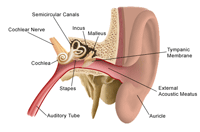Otitis Media (Middle Ear Infection)
What is a middle ear infection?

A middle ear infection is an inflammation in the air-filled space behind the eardrum. When the middle ear becomes infected, that space fills with fluid, which presses against the eardrum. This fluid buildup can be painful.
Middle ear infections can affect adults, but they are much more common in children. More than 80 percent of children have at least one ear infection by the age of 3.
There are several types of middle ear infection:
- Acute otitis media (AOM): This type of ear infection comes on relatively suddenly. The middle ear becomes swollen and red. Fluid and mucus are trapped inside, causing fever, ear pain and hearing loss.
- Otitis media with effusion (OME): The infection subsides, but fluid (effusion) and mucus continue to collect in the middle ear. Your child may experience a feeling of fullness in the ear and hearing loss.
- Chronic otitis media with effusion (COME): With this condition, the infection clears up, but fluid either stays in the middle ear or returns again and again. As a result, your child may have hearing loss and difficulty fighting new infections.
Causes of ear infection
The middle ear can become infected when the narrow tube (called the Eustachian tube) that connects it to the back of the nose stops working properly. The Eustachian tube keeps air pressure from building up and drains fluid from the middle ear. A cold or allergy can cause the lining of the nose, throat and eustachian tube to swell and become congested. Bacteria and viruses can grow when fluid becomes trapped inside.
Young children are more likely than adults to get ear infections because their eustachian tubes are shorter, narrower and horizontal. This makes it easier for bacteria to get in and more difficult for fluid to drain. Also, young children have weaker immune systems, making it harder for them to fight off infection.
While anyone may develop an ear infection, a child is more likely to get one if he or she:
- Has a family history of ear infections
- Has a poor immune system
- Is around someone who smokes/air pollution
- Spends time in a daycare setting
- Is bottle-fed instead of breastfed or pacifier use
- Drinks from a bottle while laying on his or her back
Signs and symptoms of ear infection
Your child may experience some of these common symptoms of an ear infection:
- Ear pain (most common complaint)
- Unusual irritability
- Difficulty sleeping or staying asleep
- Tugging or pulling at one or both ears
- Fever
- Fluid draining from the ear
- Loss of balance
- Hearing difficulties
- Poor feeding
The symptoms of an ear infection may resemble other conditions or medical problems. Always consult your child's physician for a diagnosis.
Testing and diagnosis for ear infection
In addition to a complete medical history and physical examination, your child’s primary care provider will look inside your child’s ear using a lighted instrument called a pneumatic otoscope. This instrument will blow a gentle puff of air against the eardrum. If the eardrum does not move, it’s likely because fluid has built up behind it. Frequent ear infections or chronic fluid accumulation behind the middle ear could cause a problem with hearing. A hearing test or referral to a specialist might be indicated if your child has frequent ear infections.
Treatment for ear infection
Your child’s physician will consider the following when determining how best to treat the ear infection:
- Your child's age, overall health and medical history
- The extent of the condition
- Your child's tolerance for specific medications, procedures or therapies
- Whether the infection is likely to clear up on its own
- Your opinion or preference
Treatment may include:
- Antibiotic medication by mouth or ear drops
- Pain medication
If fluid remains in the ear for longer than three months, your child's physician may suggest placing small tubes in the ear. Ear tubes are tiny cylinders, usually made of plastic and sometimes metal, that are surgically inserted into your child’s eardrum. These tubes allow air to flow in and out of the middle ear, which prevents the development of negative pressure as well as fluid build-up. Ear tubes may also be called tympanostomy tubes, myringotomy tubes or ventilation tubes.
Your child's hearing should return to normal after the fluid is drained. The tubes usually fall out on their own after six to 12 months.
Your child’s surgeon may also recommend removing the adenoids if they are also infected. The adenoids are pads of lymph tissue in the soft roof of the mouth. When they become swollen, they can block the eustachian tubes and prevent them from draining. Removing the adenoids may help prevent ear infections.
Outlook for children with ear infection
Often, middle ear infections will resolve on their own or shortly after starting a prescription antibiotic. If an ear infection does not resolve on its own and remains untreated, your child can experience other symptoms and illness including:
- Infection in other parts of the head
- Problems with speech and language development
- Permanent hearing loss
Reviewed by Kimberly L. Bennett, DNP, CRNP, CPNP-PC, PMHS

